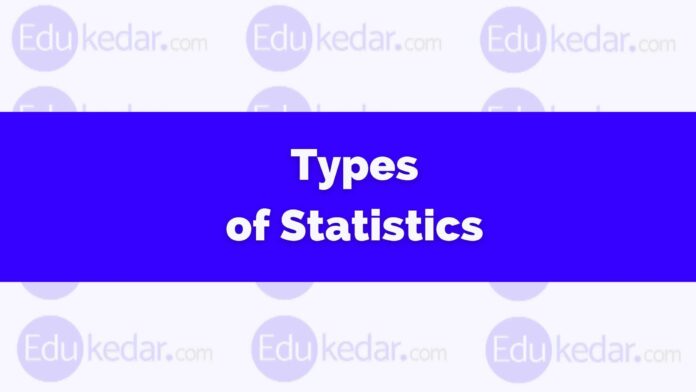Statistics involves the use of mathematical methods and techniques to extract meaning and insights from data. There are two types of Statistics; descriptive statistics and inferential statistics.
Statistics is a branch of mathematics that deals with the collection, analysis, interpretation, presentation, and organization of data. Here we have shared the types of statistics in this article.
Types of Statistics
Statistics can be broadly categorized into two main types.
- Descriptive statistics
- Inferential statistics
1. Descriptive Statistics
Descriptive statistics is a branch of statistics that deals with the collection, analysis, and presentation of data in a way that allows for a better understanding of its characteristics. The goal of descriptive statistics is to summarize and describe a set of data, rather than drawing inferences or conclusions about a larger population based on the data.
- Measures of Central Tendency used in descriptive statistics include the mean, median, and mode, which are used to describe the typical or most common value in a set of data.
- Mean
- Median
- Mode
- Measures of Variability, such as range, variance, and standard deviation, are used to describe how spread out the data is around the central tendency.
- Range
- Variance
- Dispersion
Measures of Central Tendency
Mean, median, and mode are common measures of central tendency used in statistics to describe the typical or central value of a set of data.
Mean
The mean is the sum of all the values in a dataset divided by the total number of values. It is also called the arithmetic mean. The mean is sensitive to extreme values, which can skew the value of the mean. For example, in a dataset of test scores, one or two very high or very low scores can significantly affect the mean score.
Median
The median is the middle value in a dataset, such that half of the values are above it and half are below it. The median is less sensitive to extreme values than the mean. For example, in a dataset of test scores, the median score will be unaffected by one or two very high or very low scores.
Mode
The mode is the value that appears most frequently in a dataset. It is the only measure of central tendency that can be used for nominal data (data that cannot be ordered or ranked). For example, in a dataset of favorite colors, the mode would be the color that appears most frequently.
All three measures of central tendency have their strengths and weaknesses and are useful in different contexts. In general, the choice of which measure to use depends on the type of data, the purpose of the analysis, and the specific question being asked.
Measures of Variability
Range, variance, and dispersion are measures of variability used in statistics to describe how spread out the values in a dataset are around the central tendency.
Range
The range is the difference between the largest and smallest values in a dataset. It is a simple measure of variability that is easy to calculate, but it is sensitive to extreme values and may not provide a complete picture of the variability in the data.
Variance
Variance is a more robust measure of variability that takes into account all of the values in a dataset. It measures how far the values in the dataset are from the mean. A high variance indicates that the values are widely spread out from the mean, while a low variance indicates that the values are clustered closely around the mean.
Standard deviation is the square root of the variance and provides a measure of the spread of the data in the same units as the data.
Dispersion
Dispersion is a general term that refers to how spread out the values in a dataset are around the central tendency. It can be measured using range, variance, or standard deviation.
In general, measures of variability are important in statistical analysis because they provide information about the range and spread of the data, which can affect the conclusions that can be drawn from the data.
Other commonly used descriptive statistics include frequency distributions, which show how often each value or category appears in a dataset, and graphical representations of data such as histograms, scatterplots, and box plots.
Descriptive statistics can be used in a wide range of fields, including business, finance, healthcare, social sciences, and many others.
By analyzing and summarizing data using descriptive statistics, researchers and practitioners can gain insights into the underlying patterns and trends in the data, which can inform decision-making and improve understanding of complex phenomena.
2. Inferential Statistics
Inferential statistics is a branch of statistics that uses sample data to make inferences or draw conclusions about a larger population. The goal of inferential statistics is to use a sample of data to make predictions or generalize findings to the larger population from which the sample was drawn.
Inferential statistics relies on probability theory and hypothesis testing to make inferences about population parameters based on sample statistics. For example, if a researcher wants to estimate the mean income of a population, they might take a sample of individuals from that population and use inferential statistics to estimate the population mean based on the sample mean and other sample statistics.
Some common methods used in inferential statistics include hypothesis testing, confidence intervals, and regression analysis. Hypothesis testing involves making a statement about a population parameter, such as the population means, and then using sample data to determine whether the statement is likely to be true or false. Confidence intervals provide a range of values within which the population parameter is likely to fall with a certain degree of confidence. Regression analysis is a statistical method used to examine the relationship between two or more variables.
Inferential statistics is used in a wide range of fields, including business, healthcare, social sciences, and many others. By drawing inferences and making predictions about population parameters based on sample data, researchers and practitioners can gain insights into complex phenomena and make informed decisions.
Related Posts
Other Types of Statistics
In addition to these two main types of statistics, there are several other types that are often used in various fields, including:
- Probability Theory
- Biostatistics
- Social Statistics
- Business Statistics
Probability Theory: Probability theory is a branch of mathematics that deals with the study of random events and their outcomes. It provides a framework for understanding and quantifying uncertainty and is used in many fields, including finance, engineering, and physics.
Biostatistics: Biostatistics is a branch of statistics that deals with the application of statistical methods to the study of biological and health-related data. It is used to analyze and interpret data related to diseases, medical treatments, and public health.
Social Statistics: Social statistics is a branch of statistics that deals with the analysis of social data, such as data related to social behavior, public opinion, and demographic characteristics. It is used in fields such as sociology, political science, and psychology.
Business Statistics: Business statistics is a branch of statistics that deals with the analysis and interpretation of data related to business operations, such as sales, profits, and customer behavior. It is used to make informed business decisions, such as setting prices, identifying market trends, and forecasting future performance.
Overall, statistics is a diverse field with many applications, and the different types of statistics offer various techniques and tools for analyzing and interpreting data in different contexts.





